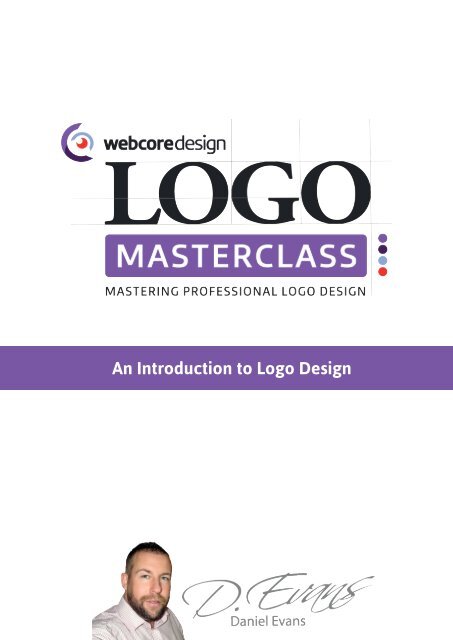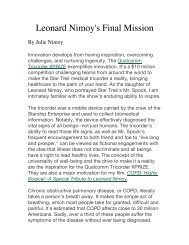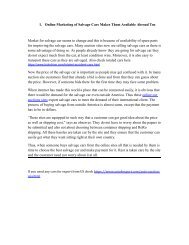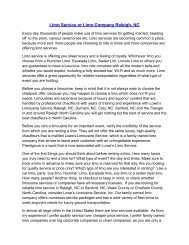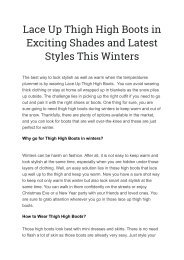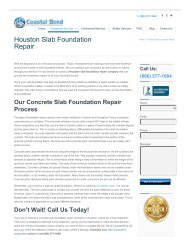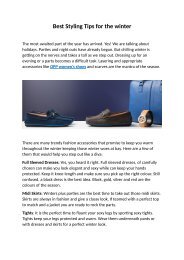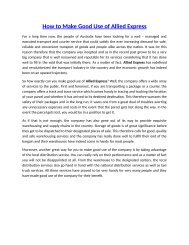Introduction to Logo Design
http://logomasterclass.com/free I’m Daniel Evans. I am a freelance graphic artist from the North-East of England with a speciality for logo design, branding and corporate identity. As well as operating my own graphic design business "Webcore Design", my past (and current) experience has involved working remotely on behalf of Hewlett Packard in Utah and design agencies in Seattle and New York and various agencies in Britain.
http://logomasterclass.com/free
I’m Daniel Evans. I am a freelance graphic artist from the North-East of England with a speciality for logo design, branding and corporate identity. As well as operating my own graphic design business "Webcore Design", my past (and current) experience has involved working remotely on behalf of Hewlett Packard in Utah and design agencies in Seattle and New York and various agencies in Britain.
You also want an ePaper? Increase the reach of your titles
YUMPU automatically turns print PDFs into web optimized ePapers that Google loves.
An <strong>Introduction</strong> <strong>to</strong> <strong>Logo</strong> <strong>Design</strong>
An introduction <strong>to</strong> Professional <strong>Logo</strong> <strong>Design</strong><br />
Daniel Evans<br />
Terms & Conditions<br />
This digital production may be freely distributed but may NOT be modified in any way, shape or form.
An Intro <strong>to</strong> the Author<br />
I’m Daniel Evans. I am a freelance graphic artist from the North-East of England with a speciality for logo<br />
design, branding and corporate identity. As well as operating my own graphic design business "Webcore<br />
<strong>Design</strong>", my past (and current) experience has involved working remotely on behalf of Hewlett Packard in Utah<br />
and design agencies in Seattle and New York and various agencies in Britain.<br />
My recent work is featured in the publications: IHeart<strong>Logo</strong>s Season 1, IHeart<strong>Logo</strong>s Season 2, IHeart<strong>Logo</strong>s<br />
Season 3, Damn Good, <strong>Logo</strong>s 2 - Bright Ideas in <strong>Logo</strong> <strong>Design</strong>, <strong>Logo</strong>Pond Vol 1, <strong>Logo</strong> Nest 02, <strong>Logo</strong> Lounge 7 and<br />
<strong>Logo</strong> Creed by Rockport Publishers.<br />
I hold a Wolda '10 award for 5 logo design pieces as well as a Mazie (Amazing Pixels) Award, and Silver Hiiibrand<br />
Award in the Professional <strong>Logo</strong> <strong>Design</strong> Category appearing in the magazine publication; New Graphic 30.
Types of <strong>Logo</strong> <strong>Design</strong><br />
We can break down logo types in<strong>to</strong> the following categories:<br />
Iconic <strong>Logo</strong>s<br />
This type of logo features the logo text (personal / company name) and a complimentary icon usualy displayed<br />
at the left or above the logo text. This type of design is particularly suited <strong>to</strong> those who wish <strong>to</strong> brand without<br />
its associated text. You may for instance wish <strong>to</strong> display an attractive picture throughout your website elements<br />
<strong>to</strong> build brand awareness without having <strong>to</strong> advertise your company name in every instance. Examples of iconic<br />
logos include Pepsi, Adobe and Adidas.<br />
Enclosure <strong>Logo</strong>s<br />
An enclosure logo is one that features text and a picture (or any of the two) contained with a tidy badge shape.<br />
This type of logo is useful for those who wish <strong>to</strong> advertise the company name / brand in a visually pleasing<br />
manner which can also be easily and neatly applied <strong>to</strong> a wide range of applications. Examples of enclosure<br />
logos include Starbucks, NBA and Burger King.<br />
Incorporated <strong>Logo</strong>s<br />
An incorporated logo features text with a prominent logo picture / icon embedded within. A "O" for instance in<br />
the company name "Solar" might feature a glowing sun or the "i" in the word "idea" might be portrayed by a<br />
figure with a lightbulb above their head.<br />
Type <strong>Logo</strong>s<br />
A type based logo design is useful <strong>to</strong> place emphasis on the company name rather than distract with both text<br />
and a picture. Text logos are usually primative in form although some can be very decorative with highlighted<br />
text features. Cus<strong>to</strong>m type logos usually have their characters drawn from scratch - sometimes handwritted, or<br />
they are heavily modified versions of existing fonts. It is common for large corporations <strong>to</strong> have text drawn from<br />
scratch <strong>to</strong> establish uniqueness. Examples of text based logos include Coca-Cola, IBM and Sony.
Take the Test!<br />
See if you can identify each of the four categories in the logos I’ve designed.<br />
First try <strong>to</strong> identify iconic logos, then enclosure logos, followed by incorporated logos then type logos.<br />
I will go on <strong>to</strong> colour code the answers in the following pages.
How did you do?<br />
Iconic Enclosure Incorporated Type
Results<br />
I’m sure some of the result surprised you?<br />
Namely, you thought that some logos that you thought were ‘iconic’, turned out <strong>to</strong> be ‘incorporated’ logos?<br />
If truth be <strong>to</strong>ld, there are no hard and fast rules. The terminology for some logos is subjective.<br />
I’ll explain my own reasoning for regarding some logos as ‘incorporated’ using two logos as examples:<br />
Whilst I was designing this logo, I had the option for the spear <strong>to</strong> be peircing the letters but I decided that<br />
this would make the graphic look <strong>to</strong>o busy.<br />
Instead, I placed the spear above the text and although it’s a seperate element, it is always meant <strong>to</strong> be used<br />
alongside the text. That is <strong>to</strong> say, the spear element was not specifically designed <strong>to</strong> be used as a standalone,<br />
for the fact that it’s shape (<strong>to</strong> name but one reason) isn’t compact and brandable. The entre logo, its colours and<br />
its arched shape is dependant upon the two elements (text and spear) being married.<br />
Naturally, what’s in the designers mind shouldn’t be a fac<strong>to</strong>r in judgement. Afterall, it’s the end product which<br />
stands as the object. It should be obvious <strong>to</strong> many that this logo works as a whole and its components of it<br />
should not be split.<br />
Needless <strong>to</strong> say, the client in this case did not state that they wished <strong>to</strong> have a brandable, standalone, icon.
This logo design, which was also regarded as an ‘incorporated’ logo, sees a bird <strong>to</strong> the left hand side<br />
of the text which could be regarded as a standalone icon, thus rending this graphic an ‘iconic’ logo.<br />
The clincher however is the shape beneath the ‘O’ which represents the shadow of the bird pulling the icon<br />
closer in<strong>to</strong> marriage and complimantary fusion with the text.<br />
The bird still has the potential <strong>to</strong> be separated and used as a standalone icon, however the two peices<br />
separated (bird and text) would lose their aesthetic quality and the shadow would perhaps have <strong>to</strong> be<br />
altered in its position so that the offset doesn’t appear exagerated, or it would have <strong>to</strong> be removed<br />
negating easthetic appeal further.<br />
Therefore, as this logo stands the icon of the bird with its shadow is depedant upon the text and I regard it<br />
as an ‘incorporated’ logo design.
Simplicity in <strong>Logo</strong> <strong>Design</strong><br />
It’s often instinctive for a client <strong>to</strong> demand that their logo boast the bells and whistles – inclusive of an<br />
expansive colour scheme and a range of gradients or effects. What’s overlooked is the beauty of<br />
simplicity and above all, it’s legibility <strong>to</strong> be used across all forms of medium, which may, in some cases,<br />
require the logo <strong>to</strong> be composed in basic form and colour.<br />
Businesses who trade both online and offline require simplicity in their brand. Their brand needs <strong>to</strong> be so simple<br />
that it can be recognised and registered mentally by a mere glance. It needs <strong>to</strong> be so simple that a person could<br />
doodle it within seconds from the memory they pull it from.<br />
This isn’t <strong>to</strong> say that the designers job as as simple as a quick doodle. The most difficult task a designer faces is <strong>to</strong><br />
make something simple – yet effective. Any talented designer can spend weeks developing an intricate<br />
illustration of a horse but the creative, simplistic designer might have <strong>to</strong> spend weeks thinking.<br />
There are literally hundreds are brands out there in the world that people have seen, registered and used, yet<br />
they have little concept of why the brands are working as effectively as they are on a subliminal level.<br />
K.I.S.S.<br />
‘Keep it simple Silly’ is a well known term.<br />
..which should be followed with ‘K.I.M.’<br />
Keep it Mindful.
The Nike “Swoosh” (developed in 1971 by Carolyn Davidson) functions brilliantly on so many levels<br />
which are only brought <strong>to</strong> the concious surface when we analyse. The Nike “Swoosh” can depict:<br />
* A tick – An assurance of doing something correctly or making a positive decision.<br />
* A speed trial of a person or object accelerating in<strong>to</strong> the distance.<br />
* A corner of a racetrack.<br />
You might wish <strong>to</strong> consider more, but those are the primary qualities of the logo which spring <strong>to</strong> my own mind<br />
when I “s<strong>to</strong>p and look”. The peice serves as functional brilliance on the most basic of levels. The functionality of<br />
the mark stands so strong, coupled with the past / current strong marketing campaign, it can even stand<br />
prominently without the associated “NIKE” type. Through the means of brand association and a strong mark, the<br />
company has whittled away their design further and still it stands tall. In addition, the logo mark can be seen<br />
sported in a variety of colours and in some cases, even flipped <strong>to</strong> suit the flow of their footwear shape and it still<br />
doesn’t lose it’s identity!<br />
“Simplicity is not the goal. It is the by-product of a good idea and modest expectations.”<br />
–Paul Rand (August 15, 1914 – November 26, 1996)<br />
“Simplicity is the ultimate form of sophistication. “<br />
–Leonardo da Vinci (April 15, 1452 – May 2, 1519)
Get access <strong>to</strong> 13 Pro of my <strong>Logo</strong> <strong>Design</strong> videos<br />
ABSOLUTELY FREE!<br />
http://logomasterclass.com/free


